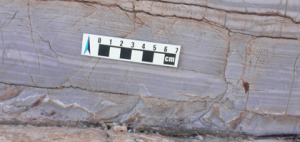
Highly laminated Keilberg Member of the Maiberg Fm, Otavi Group, N. Namibia directly overlying the “Marinoan” Chuos Formation glacial diamictite.
Nathan Miller – UT Austin
ACTIVE PROJECT: Trace elements in highly laminated basal facies of Neoproterozoic cap carbonates from several well-studied global localities are being surveyed by LA-ICP-MS to evaluate preservation and formation mechanisms. The popular conception of cap carbonates is that they form in response to the transfer of alkalinity from the atmosphere (build-up of CO2 during lengthy superglacial intervals) to the oceans (through surface diffusion and chemical weathering) during deglaciation. However, alkalinity could also derive from the deep ocean, in the form of mineralized organic matter, or from destabilization of methane hydrates. Some cap carbonate facies are persistently laminated on the scale of 10s to 1000s of microns, suggesting regulation of factors regulating carbonate precipitation and accumulation.
© 2024 Jackson School of Geosciences, The University of Texas at Austin

